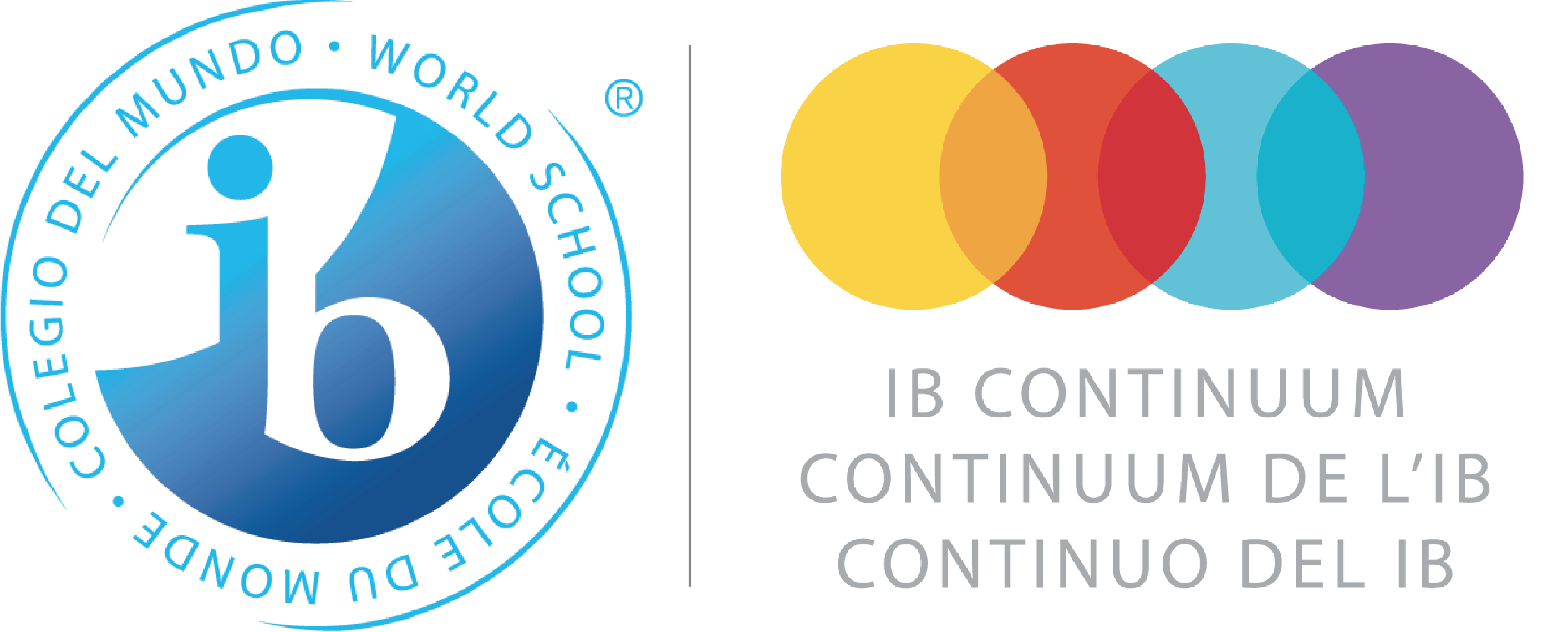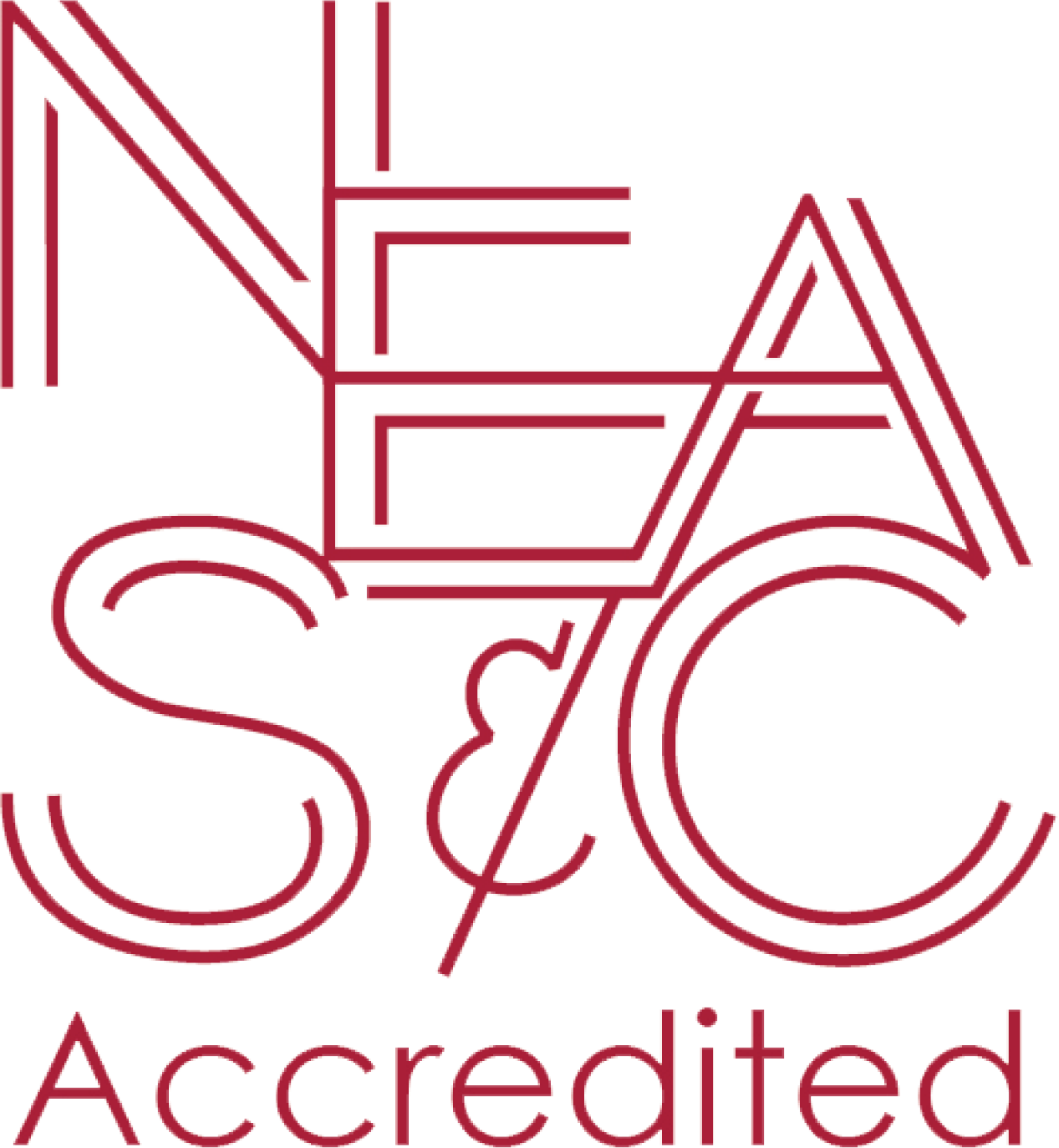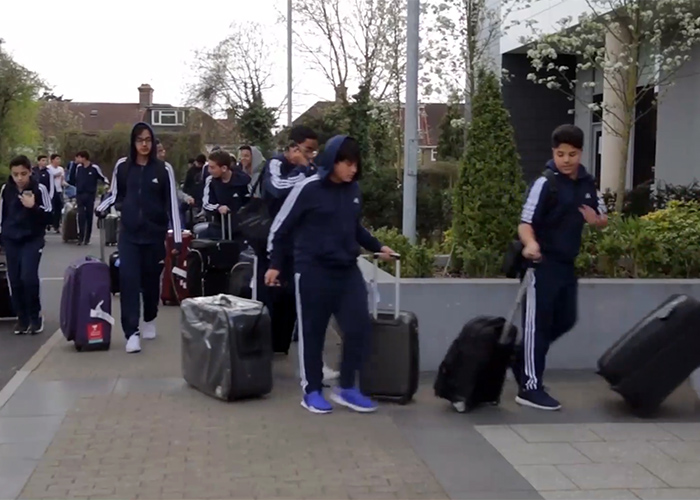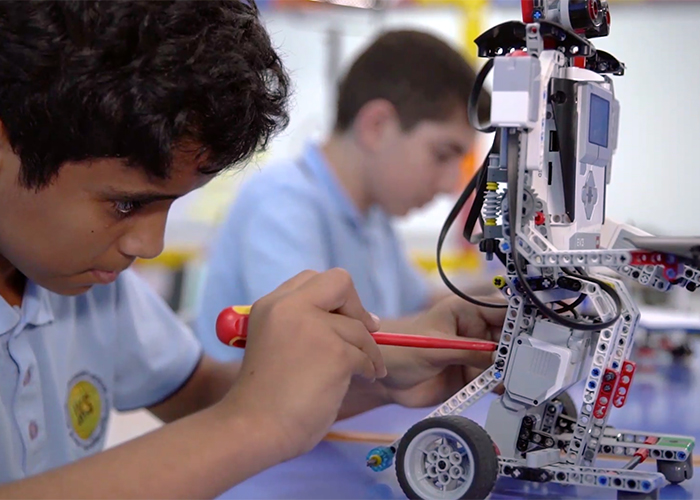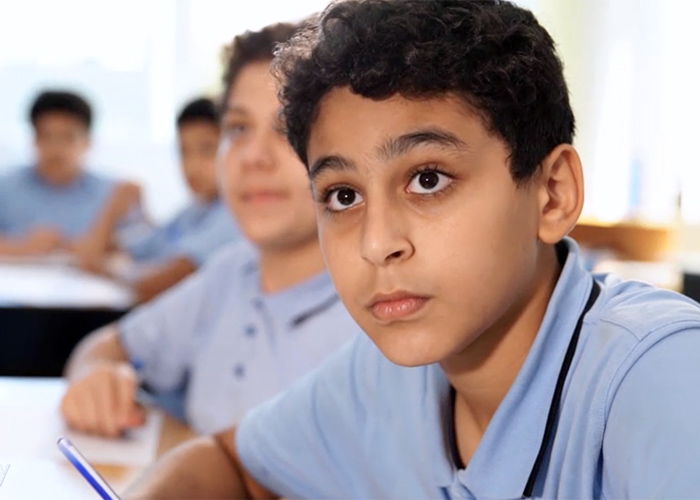Language and Literature
The aims of MYP language and literature are to encourage and enable students to:
- use language as a vehicle for thought, creativity, reflection, learning, self-expression and social interaction.
- develop the skills involved in listening, speaking, reading, writing, viewing and presenting in a variety of contexts.
- develop critical, creative and personal approaches to studying and analysing literary and non-literary texts.
- engage with text from different historical periods and a variety of cultures.
- explore and analyse aspects of personal, host and other cultures through literary and non-literary texts.
- explore language through a variety of media and modes.
- develop a lifelong interest in reading.
- apply linguistic and literary concepts and skills in a variety of authentic contexts.
Objectives
A Analysing
Through the study of language and literature students are enabled to deconstruct texts in order to identify their essential elements and their meaning. Analysing involves demonstrating an understanding of the creator’s choices, the relationships between the various components of a text and between texts, and making inferences about how an audience responds to a text, as well as the creator’s purpose for producing text. Students should be able to use the text to support their personal responses and ideas. Literacy and critical literacy are essential lifelong skills; engaging with texts requires students to think critically and show awareness of, and an ability to reflect on, different perspectives through their interpretations of the text.
In order to reach the aims of studying language and literature, students should be able to:
- analyse the content, context, language, structure, technique and style of text(s) and the relationships among texts.
- analyse the effects of the creator’s choices on an audience.
- justify opinions and ideas, using examples, explanations and terminology.
- evaluate similarities and differences by connecting features across and within genres and texts.
B Organizing
Students should understand and be able to organize their ideas and opinions using a range of appropriate conventions for different forms and purposes of communication. Students should also recognize the importance of maintaining academic honesty by respecting intellectual property rights and referencing all sources accurately.
In order to reach the aims of studying language and literature, students should be able to:
- employ organizational structures that serve the context and intention.
- organize opinions and ideas in a sustained, coherent and logical manner.
- use referencing and formatting tools to create a presentation style suitable to the context and intention.
C Producing text
Students will produce written and spoken text, focusing on the creative process itself and on the understanding of the connection between the creator and his or her audience. In exploring and appreciating new and changing perspectives and ideas, students will develop the ability to make choices aimed at producing texts that affect both the creator and the audience.
In order to reach the aims of studying language and literature, students should be able to:
- produce texts that demonstrate insight, imagination and sensitivity while exploring and reflecting critically on new perspectives and ideas arising from personal engagement with the creative process.
- make stylistic choices in terms of linguistic, literary and visual devices, demonstrating awareness of impact on an audience.
- select relevant details and examples to develop ideas.
D Using Language
Students have opportunities to develop, organize and express themselves and communicate thoughts, ideas and information. They are required to use accurate and varied language that is appropriate to the context and intention. This objective applies to, and must include, written, oral and visual text, as appropriate.
In order to reach the aims of studying language and literature, students should be able to:
- use appropriate and varied vocabulary, sentence structures and forms of expression.
- write and speak in a register and style that serve the context and intention.
- use correct grammar, syntax and punctuation.
- spell (alphabetic languages), write (character languages) and pronounce with accuracy.
- use appropriate non-verbal communication techniques.
Language Acquisition
The aims of the teaching and learning of MYP language acquisition are to:
- gain proficiency in an additional language while supporting maintenance of their mother tongue and cultural heritage.
- develop a respect for, and understanding of, diverse linguistic and cultural heritages.
- develop the student’s communication skills necessary for further language learning, and for study, work and leisure in a range of authentic contexts and for a variety of audiences and purposes.
- enable the student to develop multiliteracy skills through the use of a range of learning tools, such as multimedia, in the various modes of communication.
- enable the student to develop an appreciation of a variety of literary and non-literary texts and to develop critical and creative techniques for comprehension and construction of meaning.
- enable the student to recognize and use language as a vehicle of thought, reflection, self-expression and learning in other subjects, and as a tool for enhancing literacy.
- enable the student to understand the nature of language and the process of language learning, which comprises the integration of linguistic, cultural and social components.
- offer insight into the cultural characteristics of the communities where the language is spoken.
- encourage an awareness and understanding of the perspectives of people from own and other cultures, leading to involvement and action in own and other communities.
- foster curiosity, inquiry and a lifelong interest in, and enjoyment of, language learning.
Objectives
A Listening
Comprehending spoken language presented in multimodal text encompasses aspects of listening and viewing. The process involves the student in interpreting and constructing meaning from spoken and multimodal text to understand how images and other spatial aspects presented with oral text interplay to convey ideas, values and attitudes. Engaging with text requires the student to think creatively and critically about what is viewed, and to be aware of opinions, attitudes and cultural references presented in the visual text. The student might, for example, reflect on feelings and actions, imagine himself or herself in another’s situation, or gain new perspectives and develop empathy, based on what he or she has understood in the text.
In order to reach the aims of language acquisition, as appropriate to the proficiency level, students should be able to:
- demonstrate understanding of explicit and implicit spoken information in multimodal texts
- demonstrate understanding of conventions
- demonstrate understanding of relationships between the various components of the multimodal text
B Reading
Comprehending written language presented with multimodal text encompasses aspects of reading and viewing. It involves the student in constructing meaning and interpreting written, spatial and visual aspects of texts to understand how images presented with written text interplay to convey ideas, values and attitudes. Engaging with text requires the student to think creatively and critically about what is read and viewed, and to be aware of opinions, attitudes and cultural references presented in the written text. The student might, for example, reflect on feelings and actions, imagine himself or herself in another’s situation, gain new perspectives and develop empathy, based on what he or she has understood in the text.
In order to reach the aims of language acquisition, as appropriate to the proficiency level, students should be able to:
- demonstrate understanding of explicit and implicit written information in multimodal texts
- demonstrate understanding of conventions
- demonstrate understanding of relationships between the various components of the multimodal text
C Speaking
In the language acquisition classroom, students will have opportunities to develop their communication skills by interacting on a range of topics of personal, local and global interest and significance, with the support of spoken, written and visual texts in the target language (multimodal texts). When speaking in the target language, students apply their understanding of linguistic and literary concepts to develop a variety of structures, strategies and techniques with increasing skill and effectiveness. This is the use of the language system, including their use of grammar, pronunciation and vocabulary.
In order to reach the aims of language acquisition, as appropriate to the proficiency level, students should be able to:
- use spoken language to communicate and interact with others
- demonstrate accuracy and fluency in speaking
- communicate clearly and effectively
- communicate clearly and effectively
D Writing
This objective relates to the correct and appropriate use of the written target language. It involves recognizing and using language suitable to the audience and purpose, for example, the language used at home, the language of the classroom, formal and informal exchanges, and social and academic language. When writing in the target language, students apply their understanding of language, form, mode, medium and literary concepts to express ideas, values and opinions in creative and meaningful ways. They develop a variety of structures using strategies (spelling, grammar, plot,
character, punctuation, voice, format, audience) and techniques with increasing skill and effectiveness.
In order to reach the aims of language acquisition, as appropriate to the proficiency level, students should be able to:
- use written language to communicate with others
- demonstrate accurate use of language conventions
- organize information in writing
- communicate information with a sense of audience and purpose.
Mathematics
The aims of MYP mathematics are to encourage and enable students to:
- enjoy mathematics, develop curiosity and begin to appreciate its elegance and power.
- develop an understanding of the principles and nature of mathematics.
- communicate clearly and confidently in a variety of contexts.
- develop logical, critical and creative thinking.
- develop confidence, perseverance, and independence in mathematical thinking and problem-solving.
- develop powers of generalization and abstraction.
- apply and transfer skills to a wide range of real-life situations, other areas of knowledge and future developments.
- appreciate how developments in technology and mathematics have influenced each other.
- appreciate the moral, social and ethical implications arising from the work of mathematicians and the applications of mathematics.
- appreciate the international dimension in mathematics through an awareness of the universality of mathematics and its multicultural and historical perspectives.
- appreciate the contribution of mathematics to other areas of knowledge.
- develop the knowledge, skills and attitudes necessary to pursue further studies in mathematics.
- develop the ability to reflect critically upon their own work and the work of others.
Objectives
A Knowing and Understanding
Knowledge and understanding are fundamental to studying mathematics and form the base from which to explore concepts and develop skills. This objective assesses the extent to which students can select and apply mathematics to solve problems in both familiar and unfamiliar situations in a variety of contexts.
In order to reach the aims of mathematics, students should be able to:
- select appropriate mathematics when solving problems in both familiar and unfamiliar situations.
- apply the selected mathematics successfully when solving problems.
- solve problems correctly in a variety of contexts..
B Investigating patterns
Investigating patterns allows students to experience the excitement and satisfaction of mathematical discovery. Working through investigations encourages students to become risk-takers, inquirers and critical thinkers. The ability to inquire is invaluable in the MYP and contributes to lifelong learning.
In order to reach the aims of mathematics, students should be able to:
- select and apply mathematical problem-solving techniques to discover complex patterns.
- describe patterns as general rules consistent with findings.
- prove, or verify and justify, general rules.
C Communicating
Mathematics provides a powerful and universal language. Students are expected to use appropriate mathematical language and different forms of representation when communicating mathematical ideas, reasoning and findings, both orally and in writing.
In order to reach the aims of mathematics, students should be able to:
- use appropriate mathematical language (notation, symbols and terminology) in both oral and written explanations.
- use appropriate forms of mathematical representation to present information.
- move between different forms of mathematical representation.
- communicate complete, coherent and concise mathematical lines of reasoning.
- organize information using a logical structure.
D Applying mathematics in real-life contexts
MYP mathematics encourages students to see mathematics as a tool for solving problems in an authentic real-life context. Students are expected to transfer theoretical mathematical knowledge into real-world situations and apply appropriate problem-solving strategies, draw valid conclusions and reflect upon their results.
In order to reach the aims of mathematics, students should be able to:
- identify relevant elements of authentic real-life situations.
- select appropriate mathematical strategies when solving authentic real-life situations.
- apply the selected mathematical strategies successfully to reach a solution.
- justify the degree of accuracy of a solution.
- justify whether a solution makes sense in the context of the authentic real-life situation.
Sciences
The aims of MYP sciences are to encourage and enable students to:
- understand and appreciate science and its implications.
- consider science as a human endeavour with benefits and limitations.
- cultivate analytical, inquiring and flexible minds that pose questions, solve problems, construct explanations and judge arguments.
- develop skills to design and perform investigations, evaluate evidence and reach conclusions.
- build an awareness of the need to effectively collaborate and communicate.
- apply language skills and knowledge in a variety of real-life contexts.
- develop sensitivity towards the living and non-living environments.
- reflect on learning experiences and make informed choices.
Objectives
A Knowing and Understanding
Students develop scientific knowledge (facts, ideas, concepts, processes, laws, principles, models and theories) and apply it to solve problems and express scientifically supported judgments.
Assessment of this objective must be done using tests or exams. To reach the highest level students must make scientifically supported judgments about the validity and/or quality of the information presented to them. Assessment tasks could include questions dealing with “scientific claims” presented in media articles, or the results and conclusions from experiments carried out by others, or any question that challenges students to analyse and examine the information and allows them to outline arguments about its validity and/or quality using their knowledge and understanding of science.
In order to reach the aims of sciences, students should be able to:
- explain scientific knowledge.
- apply scientific knowledge and understanding to solve problems set in familiar and unfamiliar situations.
- analyse and evaluate information to make scientifically supported judgments.
B Inquiring and Designing
Intellectual and practical skills are developed through designing, analysing and performing scientific investigations. Although the scientific method involves a wide variety of approaches, the MYP emphasizes experimental work and scientific inquiry.
When students design a scientific investigation they should develop a method that will allow them to collect sufficient data so that the problem or question can be answered. To enable students to design scientific investigations independently, teachers must provide an open-ended problem to investigate. An open-ended problem is one that has several independent variables appropriate for the investigation and has sufficient scope to identify both independent and controlled variables. In order to achieve the highest level for the strand in which students are asked to design a logical, complete and safe method, the student would include only the relevant information, correctly sequenced.
In order to reach the aims of sciences, students should be able to:
- explain a problem or question to be tested by a scientific investigation.
- formulate a testable hypothesis and explain it using scientific reasoning.
- design scientific investigations.
C Processing and evaluating
Students collect, process and interpret qualitative and/or quantitative data, and explain conclusions that have been appropriately reached. MYP sciences helps students to develop analytical thinking skills, which they can use to evaluate the method and discuss possible improvements or extensions.
In order to reach the aims of sciences, students should be able to:
- present collected and transformed data.
- interpret data and explain results using scientific reasoning.
- evaluate the validity of a hypothesis based on the outcome of the scientific investigation.
- evaluate the validity of the method.
- explain improvements or extensions to the method.
D Reflecting on the impacts of science
Students gain global understanding of science by evaluating the implications of scientific developments and their applications to a specific problem or issue. Varied scientific language will be applied in order to demonstrate understanding. Students are expected to become aware of the importance of documenting the work of others when communicating in science.
Students must reflect on the implications of using science, interacting with one of the following factors: moral, ethical, social, economic, political, cultural or environmental, as appropriate to the task. The student’s chosen factor may be interrelated with other factors.
In order to reach the aims of sciences, students should be able to:
- explain the ways in which science is applied and used to address a specific problem or issue.
- discuss and evaluate the various implications of the use of science and its application in solving a specific problem or issue.
- apply scientific language effectively.
- document the work of others and sources of information used.
Individuals and Societies
The aims of MYP individuals and societies are to encourage and enable students to:
- appreciate human and environmental commonalities and diversity.
- understand the interactions and interdependence of individuals, societies and the environment.
- understand how both environmental and human systems operate and evolve.
- identify and develop concern for the well-being of human communities and the natural environment.
- act as responsible citizens of local and global communities.
- develop inquiry skills that lead towards conceptual understandings of the relationships between individuals, societies and the environments in which they live.
Objectives
A Knowing and understanding
Students develop factual and conceptual knowledge about individuals and societies.
In order to reach the aims of individuals and societies, students should be able to:
- use terminology in context.
- demonstrate knowledge and understanding of subject-specific content and concepts through descriptions, explanations and examples.
B Investigating
Students develop systematic research skills and processes associated with disciplines in the humanities and social sciences. Students develop successful strategies for investigating independently and in collaboration with others.
In order to reach the aims of individuals and societies, students should be able to:
- formulate a clear and focused research question and justify its relevance.
- formulate and follow an action plan to investigate a research question.
- use research methods to collect and record relevant information.
- evaluate the process and results of the investigation.
C Communicating
Students develop skills to organize, document and communicate their learning using a variety of media and presentation formats.
In order to reach the aims of individuals and societies, students should be able to:
- communicate information and ideas using an appropriate style for the audience and purpose.
- structure information and ideas in a way that is appropriate to the specified format.
- document sources of information using a recognized convention.
D Thinking critically
Students use critical thinking skills to develop and apply their understanding of individuals and societies and the process of investigation.
In order to reach the aims of individuals and societies, students should be able to:
- discuss concepts, issues, models, visual representation and theories.
- synthesize information to make valid arguments.
- analyse and evaluate a range of sources/data in terms of origin and purpose, examining values and limitations.
- interpret different perspectives and their implications.
Physical and health education
The aims of MYP physical and health education are to encourage and enable students to:
- use inquiry to explore physical and health education concepts.
- participate effectively in a variety of contexts.
- understand the value of physical activity.
- achieve and maintain a healthy lifestyle.
- collaborate and communicate effectively.
- build positive relationships and demonstrate social responsibility.
- reflect on their learning experiences.
Objectives
A Knowing and understanding
Students develop knowledge and understanding about health and physical activity in order to identify and solve problems.
In order to reach the aims of physical and health education, students should be able to:
- explain physical health education factual, procedural and conceptual knowledge.
- apply physical and health education knowledge to analyse issues and solve problems set in familiar and unfamiliar situations.
- apply physical and health terminology effectively to communicate understanding.
B Planning for performance
Students through inquiry design, analyse, evaluate and perform a plan in order to improve performance in physical and health education.
In order to reach the aims of physical and health education, students should be able to:
- design, explain and justify plans to improve physical performance and health.
- analyse and evaluate the effectiveness of a plan based on the outcome.
C Applying and performing
Students develop and apply practical skills, techniques, strategies and movement concepts through their participation in a variety of physical activities.
In order to reach the aims of physical and health education, students should be able to:
- demonstrate and apply a range of skills and techniques effectively.
- demonstrate and apply a range of strategies and movement concepts.
- analyse and apply information to perform effectively.
D Reflecting and improving performance
Students enhance their personal and social development, set goals, take responsible action and reflect on their performance and the performance of others.
In order to reach the aims of physical and health education, students should be able to:
- explain and demonstrate strategies that enhance interpersonal skills.
- develop goals and apply strategies to enhance performance.
- analyse and evaluate performance.
Arts
a. The aims of MYP arts are to encourage and enable students to:
- enjoy lifelong engagement with the arts
- explore the arts across time, cultures and contexts
- understand the relationship between art and its contexts
- develop the skills necessary to create and to perform art
- express ideas creatively
- reflect on their own development as young artists.
Objectives
A Investigating
Through the study of art movements or genres and artworks/performances, students come to understand and appreciate the arts. They use and further develop their research skills to draw on a range of sources, understanding that, in the arts, sources are not limited to texts; they can also include audio and video recordings, images and musical notation. All sources used must be referenced in accordance with the school’s academic integrity policy.
Students use and further develop information literacy skills to evaluate and select relevant information about the art movement or genre and artworks/performances. While contextual information should be included, the focus of the investigation is the art genre or movement and artworks/performances, not extensive biographical information about artists. Students learn how to critique the artworks/performances of others and to communicate in subject-specific language or terminology; this will be important in order to access the higher levels in criterion A ii. Using knowledge and understanding of the role of the arts in context, students inform their own work and artistic perspectives.
In order to achieve the aims of arts, students should be able to:
- investigate a movement or genre in their chosen arts discipline, related to the statement of inquiry
- critique an artwork or performance from the chosen movement or genre.
B Developing
Development of ideas through practical exploration provides the opportunity for active participation in the art form. Practical exploration requires students to acquire and develop skills/techniques and to experiment with the art form. Evidence of practical exploration cannot be limited to written form; for example, if a student is composing music, evidence should include musical notation and/or audio recordings; if a student is creating a piece of theatre, evidence should include script extracts and/or video recordings. To achieve the higher levels in criterion B, students must evidence extensive and varied practical exploration and refinement of their idea(s). Students use both practical exploration and knowledge and understanding of art and artworks to purposefully inform artistic decisions.
In order to achieve the aims of arts, students should be able to:
- practically explore ideas to inform development of a final artwork or performance
- present a clear artistic intention for the final artwork or performance in line with the statement of inquiry.
C Creating/Performing
The acquisition and development of skills is evident in both process and outcome. Formative assessment supports students’ acquisition and development of skills and techniques in the process stage. The students’ command of skills and techniques is demonstrated through the creation or performance of a finalized artwork that is summatively assessed.
In order to achieve the aims of arts, students should be able to:
- Create or perform an artwork.
D Evaluating
MYP arts promote the development and application of reflection and critical-thinking skills so that students become reflective practitioners. Through reflecting on their work and on themselves, students become more aware of their own artistic development and the role that the arts play in their lives and in the world. When evaluating their own artwork or performance, students should consider elements, techniques and context. The arts process journal should be used throughout the process stage to keep a record of reflections that students can refer to when developing the final reflection. Development as an artist includes development of personal skills, such as affective
skills and problem-solving skills, as well as development of artistic skills and techniques. Students’ reflections should answer the questions: “What have I learned that can be taken forward and applied to other projects?” and “What would I do differently if I did this project again?”
In order to achieve the aims of arts, students should be able to:
- appraise their own artwork or performance
- reflect on their development as an artist.
Design
The aims of MYP design are to encourage and enable students to:
- enjoy the design process, develop an appreciation of its elegance and power.
- develop knowledge, understanding and skills from different disciplines to design and create solutions to problems using the design cycle.
- use and apply technology effectively as a means to access, process and communicate information, model and create solutions, and to solve problems.
- develop an appreciation of the impact of design innovations for life, global society and environments.
- appreciate past, present and emerging design within cultural, political, social historical and environmental contexts.
- develop respect for others’ viewpoints and appreciate alternative solutions to problems.
- act with integrity and honesty, and take responsibility for their own actions developing effective working practices.
Objectives
A Inquiring and analysing
Students are presented with a design situation, from which they identify a problem that needs to be solved. They analyse the need for a solution and conduct an inquiry into the nature of the problem.
In order to reach the aims of design, students should be able to:
- explain and justify the need for a solution to a problem for a specified client/target audience.
- identify and prioritize the primary and secondary research needed to develop a solution to the problem.
- analyse a range of existing products that inspire a solution to the problem.
- develop a detailed design brief which summarizes the analysis of relevant research.
B Developing ideas
Students write a detailed specification, which drives the development of a solution. They present the solution.
In order to reach the aims of design, students should be able to:
- develop a design specification which clearly states the success criteria for the design of a solution.
- develop a range of feasible design ideas which can be correctly interpreted by others.
- present the final chosen design and justify its selection.
- develop accurate and detailed planning drawings/diagrams and outline the requirements for the creation of the chosen solution.
C Creating the solution
Students plan the creation of the chosen solution and follow the plan to create a prototype sufficient for testing and evaluation.
In order to reach the aims of design, students should be able to:
- construct a logical plan, which describes the efficient use of time and resources, sufficient for peers to be able to follow to create the solution.
- demonstrate excellent technical skills when making the solution.
- follow the plan to create the solution, which functions as intended.
- fully justify changes made to the chosen design and plan when making the solution.
- present the solution as a whole, either:
a. in electronic form, or
b. through photographs of the solution from different angles, showing details.
D Evaluating
Students design tests to evaluate the solution, carry out those tests and objectively evaluate its success. Students identify areas where the solution could be improved and explain how their solution will impact on the client or target audience.
In order to reach the aims of design, students should be able to:
- design detailed and relevant testing methods, which generate data, to measure the success of the solution.
- critically evaluate the success of the solution against the design specification.
- explain how the solution could be improved.
- explain the impact of the solution on the client/target audience.
(Source: www.ibo.org – The Middle Year Programme Guide for Schools)

